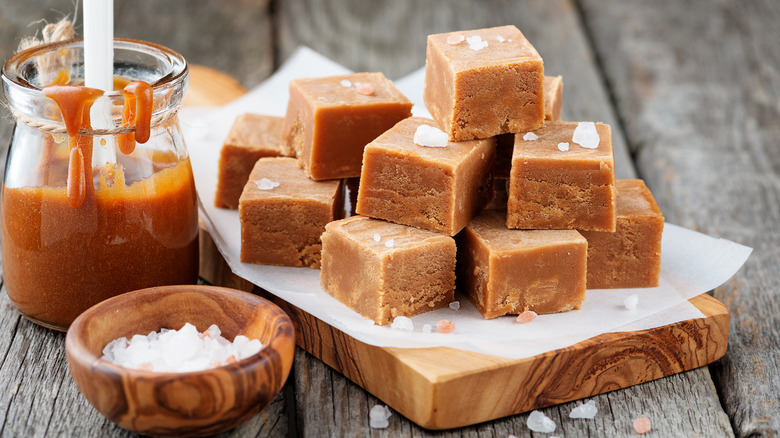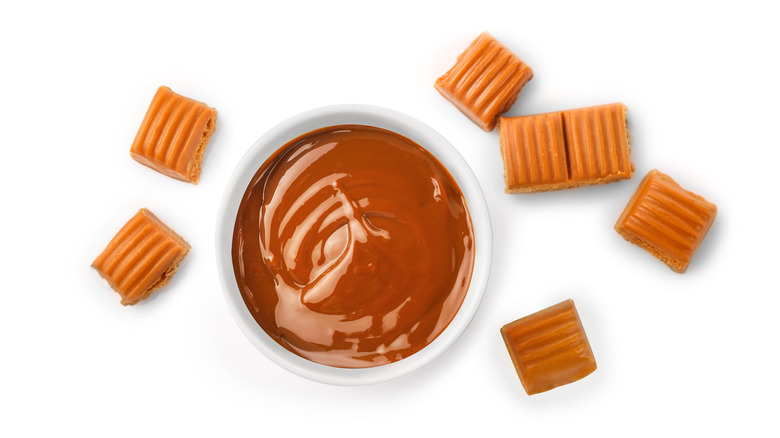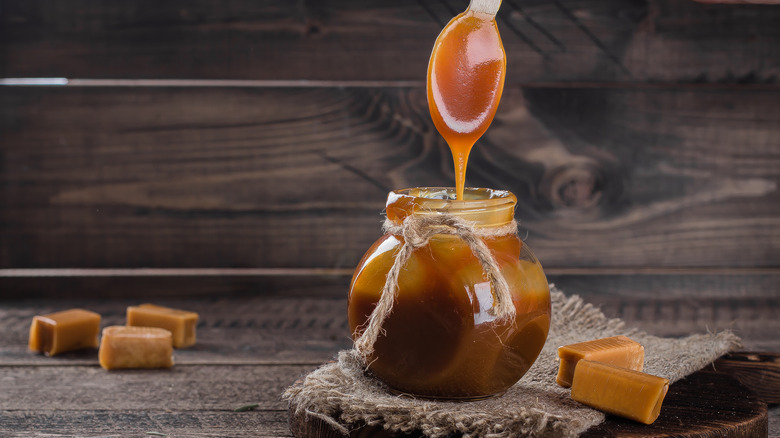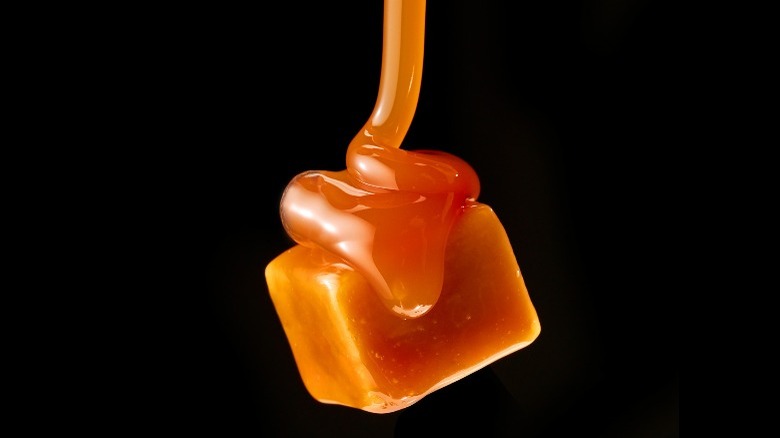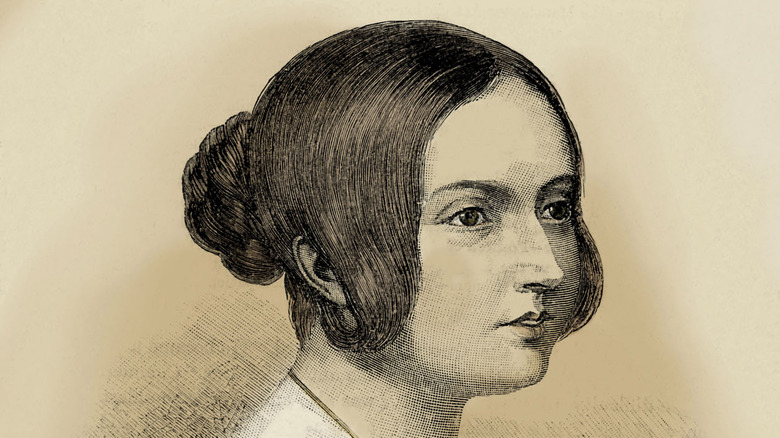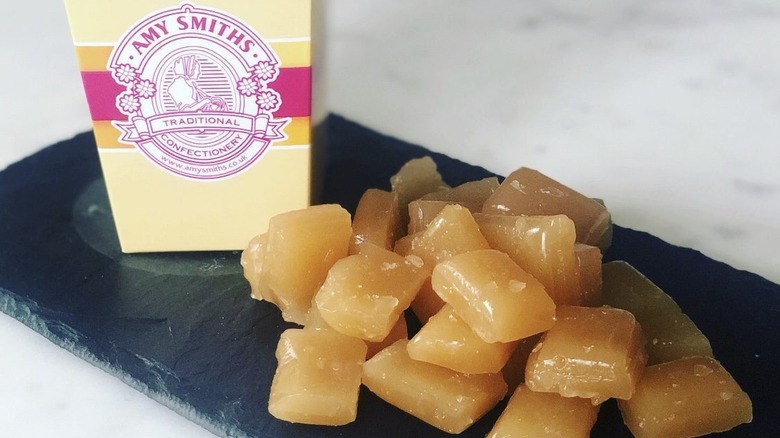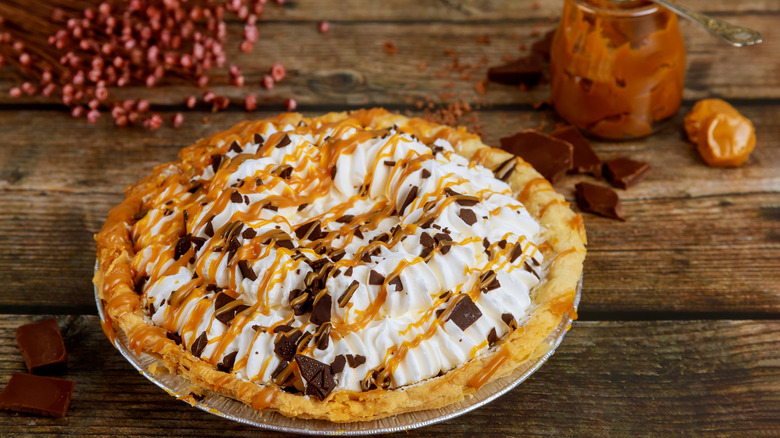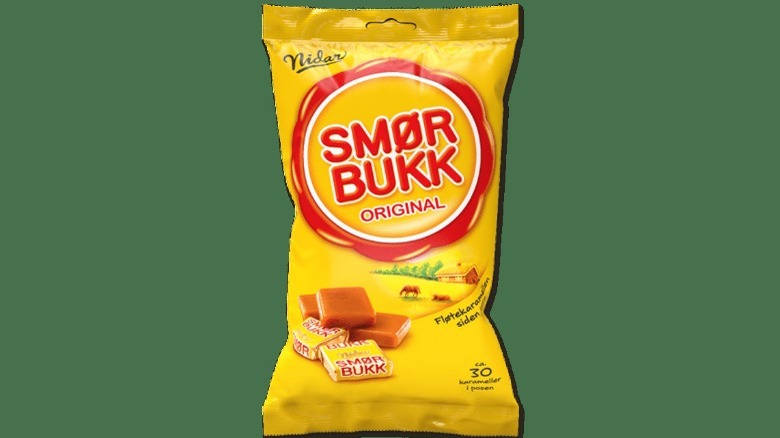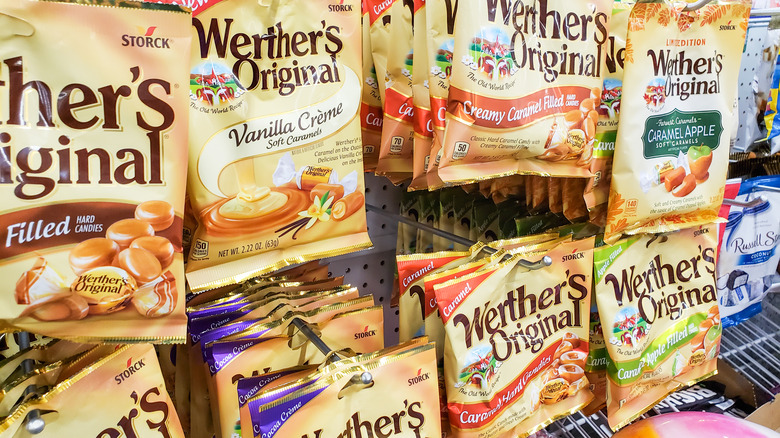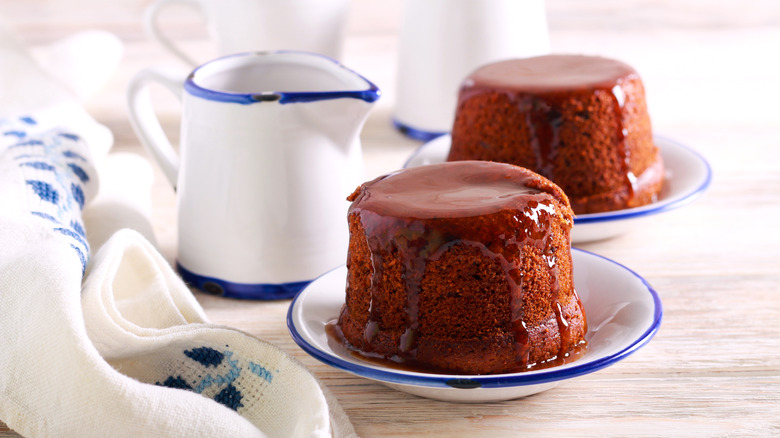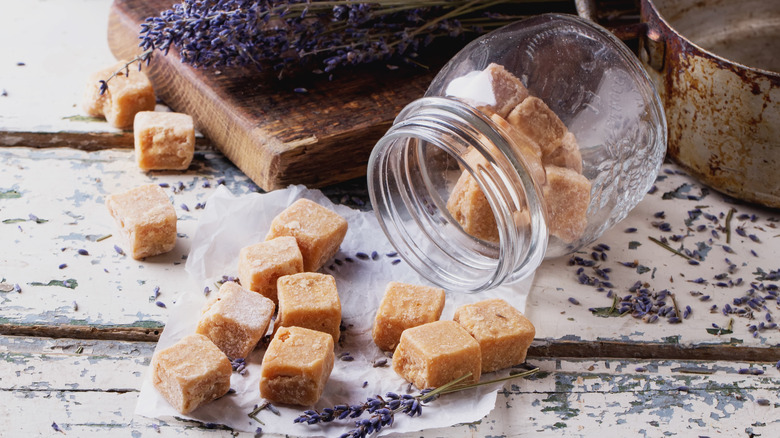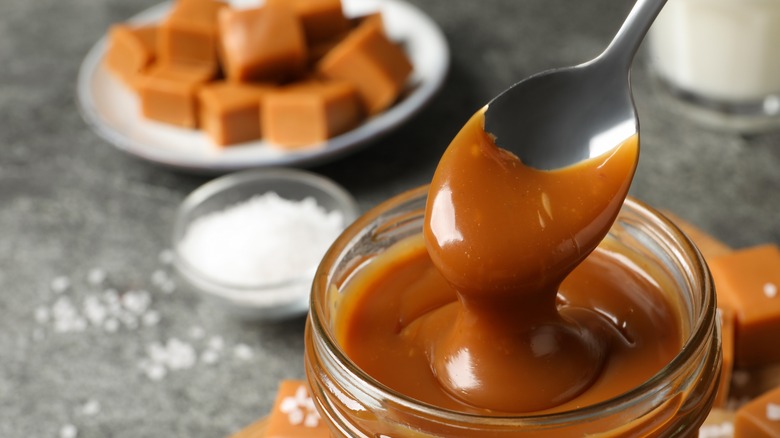The Ultimate Guide To Butterscotch
We may receive a commission on purchases made from links.
Despite its relative youth, this sweet treat has been making a splash, enticing British royals and American grandmothers for over two centuries. We are talking, of course, about butterscotch. Often associated with those glass candy dishes on the coffee table at your grandparents' house, butterscotch is a flavorful, more robust alternative to other hard sugar candies. Despite being thought of as an old, and dare we say, lame flavor, butterscotch is the relative newcomer on the block; its counterpart caramel has been around since 1000 AD.
Butterscotch has managed to evolve from its original hard candy state into its possibly more well known existence as a saucy topping for cakes and ice cream. Variations such as butterscotch pie and pudding abound, and cheap instant copies are now available to the masses — but are simply not as good as the original.
There is some uncertainty about the history of butterscotch, but we do know it is delicious. How could something made predominantly from sugar and butter not be? To help bring this classic dessert back to light, we have compiled everything you need to know about butterscotch.
Butterscotch is not caramel
There are so many different types of cooked sugar treats. From butterscotch to caramel to toffee, it can be hard to know where one stops and the other begins, but rest assured, they are all different. The first key difference between the three is the temperature they are cooked at. The higher the temperature, the higher the concentration of sugar, and the harder the final candy will be. Caramel is the softest and most naturally chewy, as it is cooked to what is known as firm ball stage between 244 and 248 F. Butterscotch is cooked to a soft crack stage, which is between 270 and 289 F. Finally, toffee is cooked to a hard crack stage, between 295 and 309 F.
Of course, when we talk about butterscotch, we're often referring to the flavor rather than the cook state. Caramel is typically made with refined white sugar, whereas butterscotch is made with brown sugar. This gives butterscotch a more robust, deeper flavor. Both caramel and butterscotch can be turned into sauce with the addition of fats from cream or butter, and it is the brown sugar flavor difference that helps distinguish the two (per Cook's Info).
The name is a mystery
What's in a name? That which we call butterscotch would by any other name still taste as sweet. And that is a good thing, because as it turns out, the term "butterscotch" is shrouded in mystery, and may have actually been called something different to begin with.
The first possibility for the name's origin is that the "scotch" part is a reference to Scotland, according to Britannica. The thought is that this would point to the candy's origins there. However, the first recorded use of the term "butterscotch" was in Douncaster, England, in 1817. This means that while it is possible the name denotes Scotland, the name more likely derives from another source.
The second possibility is the use of "scotch" in its old meaning, "to cut." It is generally hard to cut candy cleanly once cooled, so butterscotch had to be scored when warm to get a clean cut.
The third thought is that the name was actually "butterscortch" as a way to denote the scorched ingredients that went into its creation of it. The name would have then been shortened to simply butterscotch. Scotch or scorch, either way, it is still a sweet treat.
Butterscotch was created in 1800s England
While it is impossible to say for sure where butterscotch truly originated, the most generally accepted is that this confection was created by a man named Samuel Parkinson in Doncaster, England (via Boyer Candies). Parkinson was a candymaker who originally began making a butterscotch-like treat under the name of "buttery brittle toffee." In 1817, the first recorded recipe for butterscotch was documented by Parkinson. His company continued making its candy until it went out of business in 1977.
While Parkinson was the first butterscotch manufacturer, he was certainly not the last. Brands all over the world have hopped on the butterscotch train. Sweets company Boyer includes butterscotch as a coating option for the company's peanut butter cups. Nestle Tollhouse makes butterscotch chips for bakers to use at home, and who hasn't seen these nondescript yellow cellophane covered butterscotch candies sitting in a candy dish somewhere? Samuel Parkinson certainly started a candy revolution when he set pen to paper and created the first recorded recipe for butterscotch.
Butterscotch is a royal treat
If you like butterscotch, you are in good company: Queen Victoria herself was known to enjoy the sweet.
In 1851, 34 years after butterscotch's invention, Parkinson presented the monarch with a box of his creation when she opened the St. Leger Horse Race in Doncaster, according to The Star. The company had been producing St. Leger-specific butterscotch tins. This ended up being a savvy business move on Parkinson's part because Victoria, who had a renowned sweet tooth (via The New York Times), loved Parkinson's butterscotch so much that she made Parkinson's the sole royal supplier of butterscotch, boosting the company's popularity.
The royal connections don't end there, though. A century later, in 1948, then-Princess Elizabeth was presented with a tin of Parkinson's butterscotch. Sadly, Parkinson's closed in 1977, but that doesn't mean the royal family had to go without. In 2007 the Princess Royal, Princess Anne, reopened the Doncaster racecourse and was presented with a tin of butterscotch made in the confection's birthplace.
The original recipe is still in production
It is always sad to see an icon fade away. Unfortunately, after 160 years in business, Parkinson's company shuttered in 1977, according to The National Archives. As fate would have it, however, that was not the end of his butterscotch. One fanciful tale, though not one with much to back it up, is that in 2003, a local Doncaster businessman and his wife discovered an old St. Leger butterscotch tin in their basement, of all places. This on its own would be something to be excited about, but inside, they found something even more remarkable: The story goes that the couple found the original recipe for butterscotch in the tin.
Thankfully, even without this tale, the world would not be without Doncaster-made butterscotch. Amy Smith Fudge, a local and family-owned Doncaster candy maker, uses Parkinson's original recipe. The company was founded in 1986 by Amy and Alex Smith and produces fudge, toffee, and, yes, traditional butterscotch. Not only do they use the same recipe, but they also use the same production methods, cooking their butterscotch in large copper pots, the oldest of which dates all the way to 1919. The company claims to be the only producer of the original 1817 recipe.
The butterscotch pie was created accidentally
Traditional butterscotch is great, but there are so many other enjoyable ways to enjoy this brown sugar treat. Butterscotch pie, for one, is a classic. While there is some debate about the true origins of butterscotch pie, the most generally accepted is this: Across the pond from butterscotch's first home, a butterscotch revolution took place in the form of an accident.
According to the IndyStar, in 1904, Sarah Wheeler was cooking up a batch of custard pie for the Wheeler Creamery Exchange in Connersville, Indiana. She accidentally let the custard burn, which turned the pies to butterscotch. Doing what any good parent would do when faced with a large batch of unsellable pie, she fed it to her sons. Her kids loved it and said that it tasted like butterscotch, and thus this pie variety was born. The Wheeler brothers continued to serve the pie at their famous lunch counters after.
Butterscotch pie has gone on to become an American classic. Former First Lady Grace Coolidge was renowned for her recipe for the pie, which appeared in "The Delineator."
Butterscotch holds a world record
Butterscotch is a world-famous treat beloved by many. No matter how much you love it, though, you would likely have trouble beating the world record holder for the largest butterscotch ever created.
In 1997 in Trondheim, Norway, a butterscotch of nearly unfathomable proportion was created by the candy company Nidar. The butterscotch weighed 1.6 tons, or 3,527 pounds. The company used their Smorbukk-style recipe, which, strictly speaking, is not exactly butterscotch, but was good enough for the people at the Guinness World Records. The final candy measured 5.02 feet by 5.02 feet, and was over a foot and a half thick at 17.7 inches.
If you would like to try a small piece of this record-breaking butterscotch, the company still produces its Smorbukk candy. While you aren't able to buy one quite as large as the Guinness World Record-setting butterscotch, we imagine that would have been too difficult to chew anyway, and you'll likely be satisfied with the bite-sized varieties available.
Werther's is not exactly butterscotch
Nidar's Smorbukk isn't exactly butterscotch, as it doesn't contain brown sugar. And while some might think the famous Werther's Original candy could count as butterscotch because it does contain brown sugar, that still isn't quite the case.
According to the Werther's website, the company was founded in Germany in 1909 by Gustav Nebel, who created a signature "butter candy." The original recipe consisted of white sugar, brown sugar, butter, salt, and heavy cream. It had a rich, delicious flavor and a hard crack. The inclusion of ingredients such as heavy cream makes the candy ultra-rich, but is also makes it untraditional for hard candies. It contains brown sugar which means it isn't caramel. So what is it exactly? Butterscotch? Not exactly. But it isn't really caramel or toffee either. It is what the company has always said it is: a butter candy.
Today, the recipe isn't exactly the same as it was when Gustav Nebel created it, but it is still a delicious and creamy hard candy.
Butterscotch is having a resurgence
While in England, butterscotch is still associated with Duncaster Races, in the United States butterscotch candies are often associated with glass dishes of hard candy at grandparents' houses, especially those miscellaneous yellow butterscotches that have very little in the way of real ingredients in them. As one food reviewer pointed out to NPR, even her septuagenarian mother saw butterscotch as old and uncool. Butterscotch deserves better though — and in recent years it's seen a resurgence in popularity.
According to the food statistics website Taste Wise, as of 2022, butterscotch has seen a 15.61% yearly growth in popularity. Consumption is up, as is the appearance of butterscotch on restaurant menus. Rina Rapuano for NPR speculates that part of what caused the butterscotch downturn is the mass production of products such as instant puddings that just never did the flavor justice. But now, with real butterscotch and butterscotch sauces making their way back onto menus, the confection is finally seeing the respect it deserves.
Making your own is simple
We are glad to see butterscotch making its well-deserved resurgence. In addition to finding its way onto restaurant menus, butterscotch is a great addition to the home cook's repertoire. It is easy to make, and you only need four ingredients. According to the South Florida Reporter, an 1848 newspaper published the original recipe for butterscotch as part of its "Housewife's Corner." The recipe as published was "one pound of butter, one pound of sugar and a quarter of a pound of treacle, boiled together." Treacle is similar to, although not exactly the same as, molasses, the ingredient that separates brown sugar from white sugar.
While classical recipes are clearly not known for their incredibly descriptive recipes, modern-day interpretations are not much more complicated. This recipe by Jenni Fields for classic butterscotch candy is based on the original proportions but offers more specific instructions. It requires just four ingredients and 25 minutes to complete.
Butterscotch sauce can be made by adding in additional fats, such as cream. You can also turn it up a notch with the addition of ingredients such as rum.
What you can do with butterscotch
So, now you have real butterscotch. But what do you do with it? The obvious first choice is just to eat it. Butterscotch candies are shelf-stable for up to 12 months, making them an ideal treat to keep around and grab a piece of when the mood strikes you. Just don't relegate them to the bottom of a purse, as that is not good food storage for real ingredient-based candy — and butterscotch deserves more respect than that.
Butterscotch can be used for so much more than just candy. Butterscotch sauce is easily made and can be used to top desserts such as ice cream, or sticky toffee pudding. We would also not judge anyone for taking a spoon right to a jar of butterscotch sauce. Butterscotch-based desserts, such as this butterscotch pudding, are sure to delight taste buds much more than their instant counterparts.
And for those looking for an easy way to incorporate a butterscotch flavor without having to make their own, butterscotch chips are a great option. They can be used in these butterscotch brownies or chewy oatmeal butterscotch cookies.
